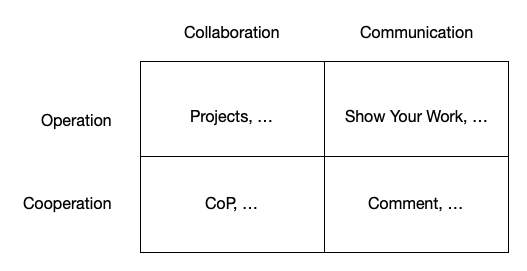For reasons that are unclear even to me, I was thinking about personalized versus adaptive learning. They’re similar in some ways, but also different. And a way to distinguish them occurred to me. It’s kinda simplistic, but I think it may help to differentiate personalized and adaptive learning.
As background, I led a project to build an intelligently adaptive learning platform. We were going to profile learners, but then also track their ongoing behavior. And, on this basis, we’d serve up something appropriate for learner X versus learner Y. (We’d actually recommend something, and they could make other choices.)
It was quite the research endeavor, actually, as the CEO had been inspired by Guilford’s learning model. I dug into that and all the learning styles literature, and cognitive factor analysis, and content models around learning objectives, and revisited my interest in intelligent tutoring, and more. I was able to hire a stellar team, and create an approach that was scientifically scrutable (e.g. no learning ‘styles’ :). We got it up and running before, well, 2001 happened and the Internet bubble burst and…
In some sense, the system was really both, in the way I’m thinking about it. I’ve seen different definitions, and one has adaptive as a subset of personalized, but I’m going a different way. I think of personalized as pre-planned alternatives for different groups, whereas adaptive reacts to the learner’s behavior.
Our use of initial profiling, if we only used that, would be personalized. The ongoing adaptation is what made it adaptive. We had rules that would prioritize preferences, but we’d also use behavior to update the learner model. It’s something they’re doing now, but we had it a couple of decades ago.
So, my simple way of thinking about personalized versus adaptive is that personalized is based upon who you are: your role, largely. We’d swap out examples on marketing for people selling services versus those selling products, for instance. Or if we’re talking negotiation, a vendor might get a different model than a lawyer.
Adaptive, on the other hand, is based upon what you do. So, for instance, if you did poorly on the last problem, we might not give you a more difficult one, but give you another at the same level. Twice in a row doing badly, we might bring you another example, or even revisit the concept. This is what intelligent tutoring systems do, they just tend to require a rigorous model of expertise.
Of course, you could get more complicated. Personalization might have a more and less supportive path, depending on your anxiety and confidence. Similarly, adaptive might throw in an encouraging remark while showing some remedial materials.
At any rate, that’s how I differentiate personalized and adaptive learning. Personalized is pre-set based upon some determined differences that suggest different learning paths. Adaptive calculates on the fly and changes what the learner sees next. How do you see it?
